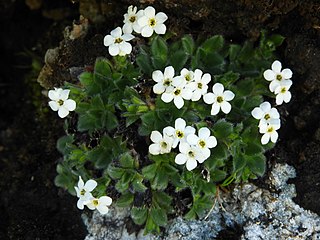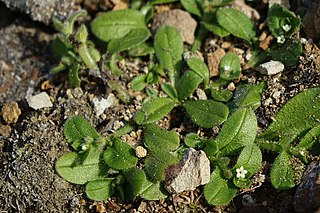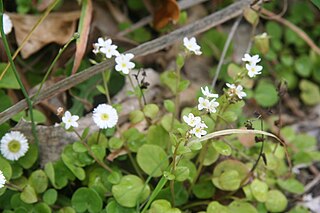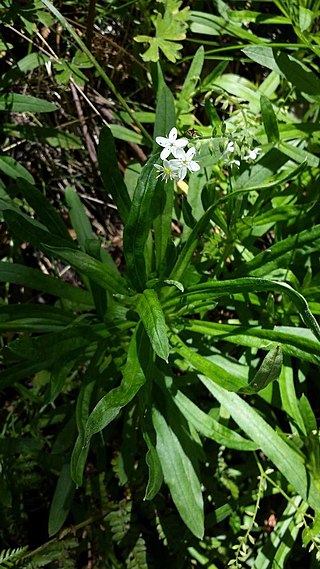
Myosotis pansa subsp. pansa, also known as the Waitakere forget-me-not, is a subspecies of flowering plant in the family Boraginaceae, endemic to the North Island of New Zealand. Lucy Moore described the variety M. petiolata var. pansa in 1961, and it was transferred to a subspecies of M. pansa by Heidi Meudt, Jessica Prebble, Rebecca Stanley and Michael Thorsen in 2013. Plants of this species of forget-me-not are perennial rosettes with ebracteate inflorescences and white corollas with exserted stamens.

Plantago hedleyi is a species of flowering plant in the plant family Plantaginaceae that is endemic to Lord Howe Island, Australia. Joseph Maiden described P. hedleyi in 1914. Plants of this plantain are large with large leaves, up to nine veins, wide petioles, and long spikes with dozens of flowers and fruits with up to 5 seeds.

Myosotis monroi is a species of flowering plant in the family Boraginaceae endemic to the South Island of New Zealand. The species was described by Thomas Cheeseman. Plants of this species of forget-me-not are perennial and erect, and have ebracteate inflorescences with cream or white corollas.

Myosotis capitata is a species of flowering plant in the family Boraginaceae, endemic to the Campbell and Auckland Islands of New Zealand. Joseph Dalton Hooker described the species in his 19th century work Flora Antarctica. Plants of this species of forget-me-not are perennial and erect, and have ebracteate inflorescences and blue corollas. It is one of two native species of Myosotis in the New Zealand subantarctic islands, the other being M. antarctica, which can also have blue corollas.

Plantago aucklandica is a species of flowering plant in the family Plantaginaceae that is endemic to the subantarctic Auckland Islands, New Zealand. Joseph Dalton Hooker described P. aucklandica in his Flora Antarctica in 1844. Plants of this plantain are large with large leaves, up to seven veins, wide petioles, colliculate seeds, and long spikes with dozens of flowers and one-seeded fruits. This species in considered to be At Risk - Naturally Uncommon, as it is an island endemic with a restricted range.

Myosotis bryonoma is a species of flowering plant in the family Boraginaceae, endemic to the South Island of New Zealand. Heidi Meudt, Jessica Prebble and Michael Thorsen described the species. Plants of this species of forget-me-not are perennial with a creeping habit, bracteate inflorescences, and white corollas.

Myosotis retrorsa is a species of flowering plant in the family Boraginaceae, endemic to the South Island of New Zealand. Heidi Meudt, Jessica Prebble and Rowan Hindmarsh-Walls described the species. Plants of this species of forget-me-not are perennial with a prostrate habit, bracteate inflorescences, and white corollas.
Myosotis umbrosa is a species of flowering plant in the family Boraginaceae, endemic to the South Island of New Zealand. Heidi Meudt, Jessica Prebble and Michael Thorsen described the species. Plants of this species of forget-me-not are perennial with a prostrate habit, bracteate inflorescences, and white corollas.

Myosotis cheesemanii is a species of flowering plant in the family Boraginaceae, endemic to the South Island of New Zealand. Donald Petrie described the species in 1886. Plants of this species of forget-me-not are perennial rosettes with bracteate inflorescences and white corollas.

Myosotis colensoi is a species of flowering plant in the family Boraginaceae, endemic to the South Island of New Zealand. Thomas Kirk described the species in 1896. Plants of this species of forget-me-not are perennial rosettes with bracteate inflorescences and white corollas.

Myosotis lyalliisubsp. elderi is a subspecies of flowering plant in the family Boraginaceae, endemic to New Zealand. Lucy Moore described Myosotis elderi in 1961, and Heidi Meudt and Jessie Prebble treated it as a subspecies of M. lyallii in 2018. Plants of this subspecies of forget-me-not are perennial with a prostrate habit, bracteate inflorescences, and white corollas with partially exserted anthers.

Myosotis antarcticasubsp. traillii is a subspecies of flowering plant in the family Boraginaceae, native to New Zealand. Thomas Kirk (botanist) described the subspecies in 1921. Plants of this subspecies of forget-me-not are perennial with a prostrate habit, bracteate inflorescences, and white corollas.

Myosotis laeta is a species of flowering plant in the family Boraginaceae, endemic to ultramafic areas of the Sounds-Nelson area of the South Island of New Zealand. Thomas Cheeseman described the species in 1885. Plants of this species of forget-me-not are perennial rosettes which form loose tufts or clumps, with ebracteate, erect inflorescences, and white corollas.

Myosotis traversiisubsp. cantabrica is a subspecies of flowering plant in the family Boraginaceae, endemic to the central South Island of New Zealand. Lucy Moore described M. traversii var. cantabrica in 1961 and Heidi Meudt changed its rank to subspecies in 2021. Plants of this subspecies of forget-me-not are perennial rosettes which form tufts or clumps, with ebracteate, erect inflorescences, and white or yellow corollas with partly exserted stamens.

Myosotis venticola is a species of flowering plant in the family Boraginaceae, endemic to the South Island of New Zealand. Heidi Meudt and Jessica Prebble described M. venticola in 2022. Plants of this forget-me-not are perennial with bracteate and prostrate inflorescences, and small, white corollas with partly exserted stamens.

Myosotis pansa is a species of flowering plant in the family Boraginaceae, endemic to the North Island of New Zealand. Lucy Moore described the variety M. petiolata var. pansa in 1961, and it was raised to species level as M. pansa by Heidi Meudt, Jessica Prebble, Rebecca Stanley and Michael Thorsen in 2013. Plants of this species of forget-me-not are perennial rosettes with ebracteate inflorescences and white corollas and exserted anthers.

Myosotis pansa subsp. praeceps is a subspecies of flowering plant in the family Boraginaceae, endemic to the North Island of New Zealand. Lucy Moore described the variety M. petiolata var. pansa in 1961, and it was transferred to a subspecies of M. pansa by Heidi Meudt, Jessica Prebble, Rebecca Stanley and Michael Thorsen in 2013. Plants of this species of forget-me-not are perennial rosettes with partially bracteate inflorescences and white corollas with exserted stamens.

Myosotis exarrhena is a species of flowering plant in the family Boraginaceae, endemic to Australia. Robert Brown described this species as Exarrhena suaveolens in 1810. Plants of this species of forget-me-not are perennial rosettes with ebracteate inflorescences and white corollas with exserted stamens.

Plantago stauntonii is a species of flowering plant in the family Plantaginaceae that is endemic to Île Amsterdam and Île Saint-Paul in the French southern territories. Sir Heinrich Wilhelm Reichardt described P. stauntonii in 1871, naming it after Sir George Leonard Staunton, who collected specimens of it in 1793.

Plantago obconica is a species of flowering plant in the family Plantaginaceae that is endemic to the South Island of New Zealand. William Sykes described the species in 1988. It is the smallest Plantago species in New Zealand. Plants of this species of plantain are perennial with a rosette habit, with very narrow, linear, keeled leaves, and fruiting capsules with a 1-cm long funnel-like base.
























